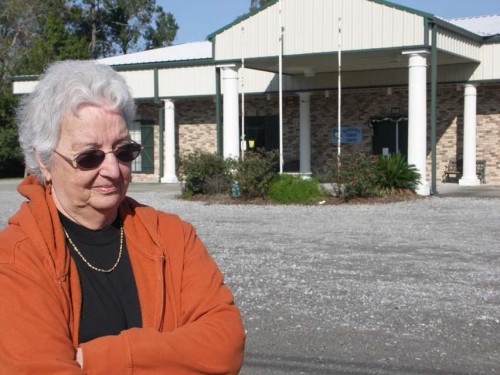
Top four corporate sponsorships you’ve never heard of
November 15, 2010Tuesday, Nov. 16
November 16, 2010A deadly mold forced regulars out of the Schriever Senior Center last spring. Since then they have moved to two nearby locations but still want to get back to their regular home, and do not understand why it has taken more then six months for officials to make repairs.
Locks have been changed on the door, drywall and insulation have been removed from some of the interior walls, a contractor’s sign for Buzz Cabinet and Millwork Remodeling LLC, once outside the structure, is no longer present, no workers have been seen at the facility in more than six weeks, and debate rages as to if the 13-year-old, 5,000-square-foot structure is safe to enter.
“They kicked us out on April 19, one day before the BP oil spill. How come in that same amount of time BP can cap that well and do cleanup, but [the Council on Aging] can’t remove a little mold?” asked Patsy Evans, chairperson of the North Terrebonne Senior Center.
Evans’ organization feeds about 100 elderly citizens on a daily basis. The center also provides a location for activities. And although the nearby St. Bridget’s Church has been hospitable in offering part time use of an annex, these residents argue that it is still not the same.
Evans said she understands and shares the senior’s frustration, having herself lost two homes to Hurricane Katrina in 2005, which prompted her to relocate to Terrebonne Parish. The retired teacher said the past six months have been unsettling.
The issue is more than a simple mold problem, according to Diana Edmonson, director of the Terrebonne Parish Council on Aging. Edmonson said that the mold in question is the deadly genus stachybotrys.
Stachybotrys commonly grows in water-damaged areas of walls, ceiling tiles, insulation, wallpaper, wood and drywall. It appears as a greenish-black fungus and can easily become airborne.
This variety of mold can be inhaled and causes bleeding in the lungs. Symptoms of those affected by stachybotrys include sudden respiratory illnesses.
Dave Roten, a retired contractor and center participant, confirmed that some local seniors have become ill, presumably because of the mold, but has insisted that the issue at hand is the amount of time it has taken officials to correct the situation. “It’s caused all kinds of problems for us,” he said.
Roten said the number of participants has declined as well due to the change in the center’s venue.
When members of the Schriever Senior Center learned that they would have to vacate the property, they were offered a space at St. Bridget’s Church. But the Department of Health ordered them out of that location because there was no hot running water. The church offered a second location, where the seniors have been meeting, but it has to be rearranged between the senior’s activities and the church’s commitments.
“What’s making us so frustrated is we have lots of our people with wheelchairs, walkers and scooters … and we’re real crowded,” Evans said.
“Seniors in that [center] are quite perturbed,” Edmonson said. “But I have to do due diligence of the agency and be as cautious as we can.”
Edmonson said that a small amount of mold remains in the center building and that plans are in the works for added cleaning and testing of the facility.
Edmonson blamed limited manpower for the delay in completing mold removal and remediation. She also said she has crews working on mold removal at her office on West Tunnel Boulevard in Houma.
Edmonson expressed frustration when asked about the Schriever Senior Center. “I’ve explained it to them,” she said. “The church has been very good to [the seniors]. They have not missed any services, all their parties, all their meals. Nothing has caused them to miss any of their activities. They just haven’t been in their particular building.”
Kevin Darbonne is a consultant with Environmental Safety and Health and worked on the Schriever Senior Center. He said that he could not talk about the details of specific projects in regard to mold level counts or costs, but could offer a general comment on the structure in question. “I can say that the levels are safe,” he said.
Darbonne said it is now simply a matter of getting the building cleaned up and back to the condition where it can be used.
“You have to understand mold remediation,” Edmonson said in response to Darbonne’s statement. “Mold remediation says if the mold on the outside of the building is more than the mold on the inside of the building that makes it safe. Now, that doesn’t make much sense to me.”
“[Darbonne] told me that sometimes it just takes time for everything to dry,” Edmonson said. “We’re trying to do our due diligence for the safety of these people. I have people on standby to do the remediation. They’re ready. I just want to be sure that we’ve cleaned the mold situation.”
Edmonson said she had no idea of a timeline as to when the seniors might be able to return to their center. She also declined to say how much the cleanup and repairs might cost. “I had hoped to have them in by Thanksgiving, but it’s not going to happen,” she said.
“We’re erring on the side of caution. I can’t get people to understand that,” Edmonson said. “Let us see if the building can be completely cleared of mold and then we will feel really good about the whole thing.”
Evans and the other seniors contend that they understand about the dangerous mold and need for repairs. They insist, however, that the process should not be taking this long. They are also suspicious as to why repairs are being made at the Council on Aging center while their location stands empty with no activity taking place.
“We are very anxious to be mold free in both areas,” Edmonson said.
North Terrebonne Senior Center Chairperson Patsy Evans is among those that wonder why the locks have been changed and mold removal work has not progressed at the Schriever Senior Center. MIKE NIXON










